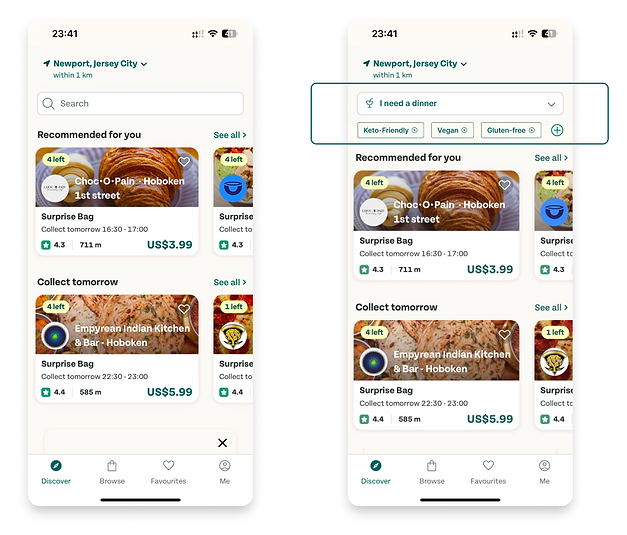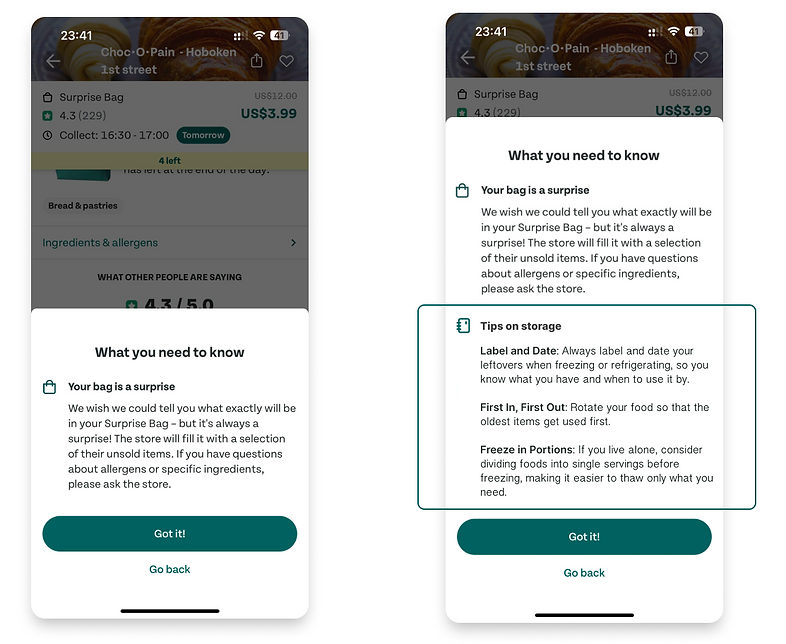Design for Health Eating Behavior Change
Redesign: Too Good To Go

Overview
This redesign is for Too Good To Go to promote healthier eating behaviors. Too Good To Go is an app and service that allows restaurants to sell the surplus food of the day at half or even less price to reduce food waste. However, there comes unhealthy eating behavior like overeating/binge eating due to the large portion of food, and miseating due to a lack of options for food.
I modified four features on the app but also aligned the product mission of saving food and kept an eye on the business model so that the redesign could be beneficial to both the company, business partners, and consumers.
Problem 01 - Healthy Eating Challenge
-
Food safety and freshness concerns
-
Large portion
-
Unbalanced nutrients and predominance of high-calorie foods
-
Lack of reference info for different dietary preferences

Problem 02 - Behavorial Problems
Impulse Buying Triggered by Deals
Limited control over food choices
Limited Control Over Food Choices
-
Disturb original eating patterns and encourage unhealthy eating patterns
-
Psychological Compulsion to Consume Purchased Food
-
Even if they don’t like the food/ find the food is not healthy
-
Overconsumption due to large portions
-
Binge eating tendencies
Problem 03 - Redesign Concerns
Mission of the App
To save surplus food
→ should not be a good dining experience guaranteed by the app
→ The user review session should be minimized.
Nature of surplus food
Varies every day in portions and categories
→ no detailed info for the food in bags - it's a secret bag
Business Partners' needs
To sell surplus food and minimize loss
→ users shouldn’t be able to select the food they want; Otherwise, some surplus food wouldn’t be moving quickly
Redesign Goal
Align with the business and missions
Attract more consumers than money/food saveer
Promoting healthy eating
Persona

Name: Nina
Age: 28
Occupation: Graphic Designer in Tech
Location: Work from home in NYC
Life: Single and live alone
I looove bakeries especially when
they are at a good price! But I want to maintain my healthy eating pattern and lifestyle.
"
Nina enjoys her healthy life. She has a respectable income in NYC but still loves to browse TGTG for cost-effective foods. However, she struggles with the large, single-nutrient portions from bakeries, which often leads to waste because she lives by herself.
Nina has reduced her frequency of using TGTG.
Prioritize healthy lifestyle
Love to try new things
Don't like to waste food
Solutions
Proposed Feature 1
Portion Control
On the checkout page, I introduced a new feature that allows customers to select their portion size instead of simply adjusting the quantity. This enhancement lets them choose a portion that best fits their needs and discourages impulse buying. The options are (1 to 2 items), medium (3 to 4 items), large (5 or more items), or whatever is left.
original interface
redesigned version

Proposed Feature 2
Health tags and filters
To minimize changes to the app's user interface and the user review section, I added a health tag feedback option to the existing Top 3 Highlights rating system. Now, users only need to take one extra step to provide feedback on the food and share it with the community. This also provides a bit more insight into the secret, although specific details cannot be revealed.
original interface
redesigned version

Additionally, to emphasize the health tags and enhance users' awareness of healthy eating, I have also incorporated health tag filters for consumers with dietary preferences focused on nutritious options.
original interface
redesigned version


Proposed Feature 3
Educational Tips
I added educational tip sections in the app at checkout to serve as helpful reminders, which include:
- A tip/instruction card included with the bags from restaurants.
- Informative content that offers tips, recipes, and advice on how to store and integrate secret items into a balanced diet.
The aim is to encourage customers to take a moment before checking out, read this information, and gain some knowledge on how to handle the food regarding receipt and storage.
original interface
redesigned version

Proposed Feature 4
Purchase with a purpose
To effectively reduce impulse buying, it's important to highlight the purpose behind mindful purchasing.
I include purposes like "need a dinner", "need grocery foods", and "need a light sweetness" as example purposes, which work as a reminder at the top of the app to restrain purchasing action mentally.
I keep the General Search as a secondary option, which doesn't discourage users from customized searches but encourages them to think about the purpose before purchasing.
original interface
redesigned version

Potential Impact & Takeaways
I aim to encourage more partner businesses that offer healthy food to join us. TGTG might expand its current consumer base by attracting users who are passionate about healthy eating and have various dietary preferences. However, this approach may lead to a decrease in impulse purchases, potentially resulting in fewer transactions for the app.
The key insight from this project is that the design must be in harmony with the business model objectives as well as stakeholders. While considering features as user reviews, I recognized that the company intentionally omitted this feature due to the app's focus on selling and saving surplus food. And, though food selection plays a crucial role in encouraging healthy eating habits, the options are inherently restricted in this context. The lesson is that it is essential to respect the business's nature and tailor the design accordingly.